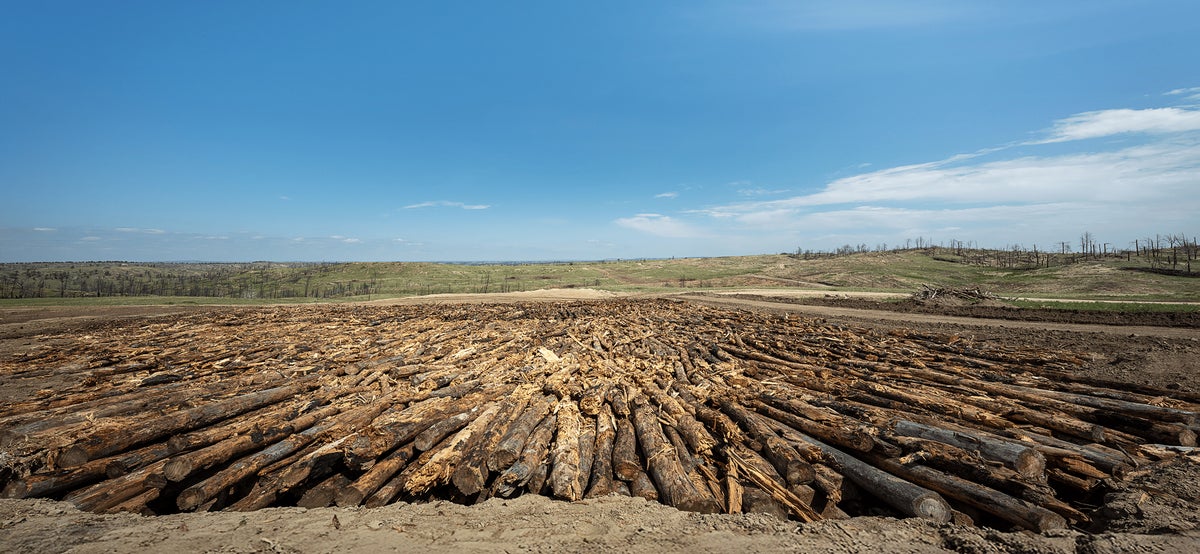Can We Bury Enough Wood to Slow Climate Change?
Wood vaulting, a simple, low-tech approach to storing carbon, has the potential to remove 12 billion tons of carbon dioxide from the atmosphere every year—and some companies are already trying it
10M lbs. of fire-killed trees loaded in chamber.
Humanity has only so much time to limit global warming and minimize the severity of future climate disasters. And with mostly tepid attempts to slash greenhouse gas emissions, researchers are scrambling for realistic ways to pull carbon out of the atmosphere. Flashy, high-tech proposals that promise to vacuum pollutants out of the sky, or to scrub them from smokestacks before they hit the atmosphere, have attracted attention and investment—but are falling far short of expectations. Now a growing number of scientists and entrepreneurs are trying a vastly simpler approach: collecting truckloads of logs, branches, wood chips and sawdust—and burying them.
Wood burial, also called wood vaulting or biomass burial, could potentially store more than 12 billion tons of carbon dioxide every year and decrease global warming by more than a third of a degree Celsius (more than half a degree Fahrenheit), according to a recent study in Nature Geoscience. This difference sounds small, but preventing a few tenths of a degree of warming could keep polar ice caps from completely disintegrating, coral reefs from collapsing and other tipping points from triggering.
If you’re enjoying this article, consider supporting our award-winning journalism by subscribing. By purchasing a subscription you are helping to ensure the future of impactful stories about the discoveries and ideas shaping our world today.
“Every year, terrestrial plants alone capture six times as much carbon as our fossil fuel emissions,” says Ning Zeng, a University of Maryland climate scientist, who has been a leader in the field of biomass burial for two decades and was not involved in the new research. “But pretty much all of that goes back into the atmosphere as leaves fall and trees die and decay.” If carbon dioxide is buried under just a few yards of dirt—where bacteria no longer have the oxygen they need to break down woody tissues—however, none or very little of it is released. If even a small fraction of woody debris that decays aboveground each year was treated this way, it would be easier to achieve the 10 billion tons per year of carbon that the Intergovernmental Panel on Climate Change (the United Nations body that is responsible for informing global climate policies) agrees must be achieved by 2050 in order to keep the planet’s temperature rise to less than two degrees C (3.6 degrees F).
There’s no reason to doubt the study’s math or methods, says Kevin Fingerman, a professor and carbon accounting expert at California State Polytechnic University, Humboldt. But as the proposed technique gets implemented in the real world, practitioners would need to carefully and accurately calculate how much carbon their vaults have kept out of the atmosphere. This would involve assessing what the fate of the wood would have been without intervention—and that’s no trivial feat. “It’s somewhere between difficult and impossible to prove what would happen to this particular pile of biomass if we hadn’t buried it,” Fingerman says. “We can never really know.”
In practice, of course, it likely won’t be feasible to divert every single scrap of wood from dumpster to earthen vault and achieve the maximum amount of carbon capture that Luo has calculated. But collecting the debris from lumber and forestry projects is feasible, and several start-ups have already begun to do so.
Construction of the first trench of the world’s first commercial-scale wood vault, near the Potomac River, where the equivalent of 100 metric tons of carbon dioxide were buried.
But no matter what’s been shown in the past, each wood vault must be robustly monitored to ensure the wood is staying stable as planned. This is why Mast, Woodcache and Carbon Lockdown design their wood vaults to include instruments that will, for example, monitor methane coming off the soil surface. Abnormally high values could indicate the wood is decomposing faster than expected, which would suggest the vault may need to be opened and potentially redesigned.
Given the investments pouring into much more complex and futuristic climate tech ventures, the implications of Luo’s paper amuse Buck. “What if the answer was just digging a hole and putting some wood in there?” she says. “A kindergartner could figure that out.”
*Editor’s Note (10/16/2025): This paragraph was updated after posting to clarify Mast Reforestation’s role in tree burial.
Syris Valentine is a freelance science journalist with a bachelor’s degree in earth and space sciences from the University of Washington. You can follow them on most social media @ShaperSyris
If you enjoyed this article, I’d like to ask for your support. Scientific American has served as an advocate for science and industry for 180 years, and right now may be the most critical moment in that two-century history.
I’ve been a Scientific American subscriber since I was 12 years old, and it helped shape the way I look at the world. SciAm always educates and delights me, and inspires a sense of awe for our vast, beautiful universe. I hope it does that for you, too.
If you , you help ensure that our coverage is centered on meaningful research and discovery; that we have the resources to report on the decisions that threaten labs across the U.S.; and that we support both budding and working scientists at a time when the value of science itself too often goes unrecognized.
In return, you get essential news, captivating podcasts, brilliant infographics, , must-watch videos, challenging games, and the science world’s best writing and reporting. You can even gift someone a subscription.
There has never been a more important time for us to stand up and show why science matters. I hope you’ll support us in that mission.
Thank you,
David M. Ewalt, Editor in Chief, Scientific American
Source: www.scientificamerican.com
